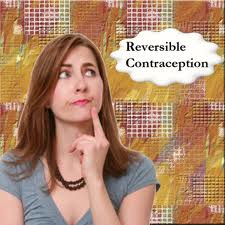 About 50% of pregnancies in the U.S. are unintended and are higher among adolescents and young women, minorities and women with less educational and financial resources. Thus strategies to prevent unintended pregnancies include assisting women at risk in choosing appropriate contraceptive methods and helping women use those methods properly and consistently. A new report prepared by the National Center for Chronic Disease Prevention and Health Promotion is now available and addresses sometimes controversial or complex issues regarding specific contraceptive methods. They utilize recommendations originally made by the World Health Organization but they have been tailored more specifically to the U.S.
About 50% of pregnancies in the U.S. are unintended and are higher among adolescents and young women, minorities and women with less educational and financial resources. Thus strategies to prevent unintended pregnancies include assisting women at risk in choosing appropriate contraceptive methods and helping women use those methods properly and consistently. A new report prepared by the National Center for Chronic Disease Prevention and Health Promotion is now available and addresses sometimes controversial or complex issues regarding specific contraceptive methods. They utilize recommendations originally made by the World Health Organization but they have been tailored more specifically to the U.S.
The relative risks of thrombotic stroke and myocardial infarction (MI) are higher among users of hormonal contraception, although absolute risks remain low, a Danish study conducted at Copenhagen University showed.
Use of oral contraceptives combining low-to-moderate doses of ethinyl estradiol and various progestins was associated with up to 2.3 times the risks of thrombotic stroke or MI compared with non-use.The type of progestin in the pill had little effect on the risks, the researchers reported in the June 14 issue of the New England Journal of Medicine.
To put the risk in perspective, they estimated that among 10,000 women taking a pill combining desogestrel with ethinyl estradiol at a dose of 20 μg for 1 year, two will have arterial thrombosis and seven will have venous thrombosis.
"Although venous thrombosis is three to four times as frequent as arterial thrombosis among young women, the latter is associated with higher mortality and more serious consequences for the survivors," they wrote. "Therefore, these figures should be taken into account when prescribing hormonal contraception."
Several previous studies have examined the relationship between hormonal contraceptive use and the risk of venous thromboembolism. But fewer have looked at arterial complications like thrombotic stroke and MI, and the results have been mixed.
In an accompanying editorial, Diana Petitti, MD, MPH, of Arizona State University in Tempe, said that the absolute increases in the risks of thrombotic stroke and MI observed in the study were small."None of the hormonal contraceptives studied ... were associated with an excess risk of stroke that was unacceptable, considering their contraceptive and noncontraceptive benefits," she wrote.
And, she added, evidence from previous studies "shows that the small risk could be minimized and perhaps eliminated by abstinence from smoking and by checking blood pressure, with avoidance of hormonal contraceptive use if blood pressure is raised."
The researchers acknowledged the study was limited by possible diagnostic misclassification, the potential for a time lag between the date of prescription and when the contraceptives were started, the lack of information on body mass index, and the incomplete information on smoking status.
Source reference:
Lidegaard Ø, et al "Thrombotic stroke and myocardial infarction with hormonal contraception" N Engl J Med 2012; 366: 2257-2566.
 Several health experts are proposing to make the birth control pill available in the U.S. without a prescription (as they are in many parts of the world). The American College of Obstetricians and Gynecologists (ACOG) released a statement calling for oral contraceptives to be sold over-the-counter, no longer requiring a doctor’s prescription.
Several health experts are proposing to make the birth control pill available in the U.S. without a prescription (as they are in many parts of the world). The American College of Obstetricians and Gynecologists (ACOG) released a statement calling for oral contraceptives to be sold over-the-counter, no longer requiring a doctor’s prescription.
ACOG considered a host of issues, including the safety of birth control pills; whether pharmacists should have a screening role (which could raise the moral objection issue) ; adherence to taking the pill; whether women would skip other preventive care if they didn’t visit a health care provider for a prescription; and cost.
ACOG addresses frequent objections to OTC oral contraceptives by concluding that “several studies have shown that women can self-screen for contraindications,” and “cervical cancer screening or sexually transmitted infection (STI) screening is not required for initiating OC use and should not be used as barriers to access.”
ACOG recognizes making the pill non-prescription might increase the cost for women who have health insurance which would only pay for prescribed drugs, and would have to pay out-of-pocket for the over-the-counter version.
The National Latina Institute for Reproductive Health issued this response to that concern: The recommendation that birth control be available over-the-counter supports what we know about Latinas and contraception: over-the-counter access will greatly reduce the systemic barriers, like poverty, immigration status and language, that currently prevent Latinas from regularly accessing birth control and results in higher rates of unintended pregnancy.
Pre-Prescribing Emergency Contraception to Teens
On a similar issue, the American Academy of Pediatrics(APP), issued a statement recognizing high teen birth rates in the United States and barriers to access to emergency contraception for adolescents 17 and younger. The AAP strongly admonishes pediatricians who refuse to discuss or provide contraception to teens based on their own beliefs, stating:
- Pediatricians have a duty to inform their patients about relevant, legally available treatment options to which they object and have a moral obligation to refer patients to other physicians who will provide and educate about those services. Failure to inform/educate about availability and access to emergency-contraception services violates this duty to their adolescent and young adult patients.
- The AAP recommends that physicians provide prescriptions to emergency contraception like Plan B in advance, so teens have it ready if and when the need arises. They also urge physicians to provide accurate information to teens on this topic, and, “At the policy level, pediatricians should advocate for increased nonprescription access to emergency contraception for teenagers regardless of age and for insurance coverage of emergency contraception to reduce cost barriers.”
HHS Urged to Remove Restrictions on Emergency Contraception
Finally, a petition is circulating urging the U.S. Department of Health and Human Services to remove restrictions on emergency contraception and make it available to women of all ages without a prescription.
SOURCE: Our Bodies, Our Selves
 A growing number of U.S. women may be opting for intrauterine devices (IUDs) as their birth control method, a national survey finds. That's good news, researchers say, since IUDs and contraceptive implants are the most effective forms of reversible birth control.
A growing number of U.S. women may be opting for intrauterine devices (IUDs) as their birth control method, a national survey finds. That's good news, researchers say, since IUDs and contraceptive implants are the most effective forms of reversible birth control.
In the U.S., though, they are still far from the most popular, with use lagging well behind birth control pills and condoms. In the new study, researchers found that in 2009, 8.5 percent of U.S. women using birth control chose an IUD or implant - with the large majority going with the IUD.
That was up from just under four percent in 2007, according to findings published in the journal Fertility and Sterility.
"We saw some pretty notable growth," said lead researcher Lawrence B. Finer of the Guttmacher Institute in New York, a sexual and reproductive health organization. Some of the possible reasons given: medical societies, like the American College of Obstetricians and Gynecologists (ACOG), have endorsed IUDs and implants; and an increase in advertisements for IUDs.
ACOG says the devices should be offered as "first-line" options for most women, because of their effectiveness and safety.
IUDs are implanted in the uterus, where they release small amounts of either copper or the hormone progestin to prevent pregnancy. It is estimated that with IUDs, between 0.2 - 0.8 % of women will have an unplanned pregnancy. It is effective for 5-10 years depending on the device. The contraceptive implant, about the size of a matchstick, is inserted under the skin of the arm, where it releases controlled amounts of progestin. The rate for unplanned pregnancy with implants is 0.05% and it works for 3 years.
"They are basically ‘set and forget' methods," Finer said.
In contrast, the Pill and condoms must be used perfectly to be most effective. And with the way people typically use them, the unintended pregnancy rate is about 9.0% per year. With condoms alone, it's between 18 and 21 percent.
More could be done to encourage U.S. women to opt for IUDs and implants, according to Finer. In some other countries, the devices are much more popular: in France and Norway, for example, about one-quarter of women on birth control use IUDs or implants. And in China, a full 41 percent do, Finer's team says in its report.
SAFETY MISCONCEPTIONS
When IUDs first came out, there were concerns that they might raise the risk of pelvic infection and jeopardize women's future fertility. So the original IUD labeling said the devices were contraindicated for women who'd never had children. But it's now known that IUDs do not carry those risks. "Many doctors continue to have outdated ideas about who can and cannot use an IUD," Finer said.
Cost may be another issue keeping women from using IUDs and implants. The devices have a big upfront cost: the price of an IUD is $500-900 which does not include the doctor's charges for putting them in. The Implanon implant costs between $400 and $800, with all charges considered.
Since the devices last for years, they are cost-effective in the long run, Finer said.
Birth control pills, for instance, cost anywhere from about $10 to $50 per month, depending on whether a woman uses generic or brand-name pills. Finer said that may change, though, with healthcare reform. The new law considers birth control part of preventive healthcare, and most health plans must cover it without co-pays and deductibles.
IUDs and implants can have unwanted side effects, however. With the implant, irregular menstrual bleeding is most common; some women stop having their periods altogether.
"There's no one best birth control method for all couples," Finer said. But he added that now that many couples are putting off having children until their 30s, more women may want to consider long-acting birth control options.
SOURCE: http://bit.ly/MRSbZO Fertility and Sterility, online July 13, 2012.
In a recent weekly press briefing, House Speaker John Boehner signaled that Republicans would not pursue legislation challenging the federal contraceptive coverage rules, Talking Points Memo reports. The requirement took effect on Aug. 1. The rules implement a provision in the Affordable Care Act that requires health plans to cover preventive services without copayments or deductibles. In February, the Obama administration announced that it would alter the rules so that religiously affiliated employers will not have to offer contraceptive coverage for their employees, but their health insurance companies will be required to provide no-cost coverage directly to women.
House GOP members have said the requirement is an attack on religious freedom. Boehner himself has said that if the Obama administration does not rescind the requirement, "then the Congress, acting on behalf of the American people and the Constitution we are sworn to uphold and defend, must."
However, Boehner took a different tone on the issue last Thursday. He said, "We're continuing to work with those groups around the country who believe that their religious liberties are being infringed to try to come to a resolution of this issue." He added, "Sometimes resolving this issue can be done other than legislative avenues. So we're continuing to work with them on the best way forward".
 A hotly contested provision of the Affordable Care Act (ACA) that requires employers and insurers to offer free contraceptive coverage takes effect today despite ongoing legal challenges.
A hotly contested provision of the Affordable Care Act (ACA) that requires employers and insurers to offer free contraceptive coverage takes effect today despite ongoing legal challenges.
Starting August 1, 2012, all new insurance policies must cover birth control and certain other preventive health services with no copay, coinsurance, or deductible. The move has riled political conservatives who say it encroaches on their religious freedom by forcing some faith-based employers to provide contraceptive coverage against their will.
While efforts to repeal the change in Congress seem to have cooled, some legal challenges (in Colorado and Michigan) are still under way to the law, which has already been delayed for certain faith-based organizations by the Obama administration.
Other women's health services for which mandated coverage begins Wednesday include free annual breast exams, prenatal care, HPV screenings, and pelvic exams. Although the changes take effect today, insurance plans won't be required to start providing the free contraception until the insurance plan's next renewal date -- Jan. 1 for most plans. Unfortunately, many state plans were renewed July 1 so it may take a full year to implement everything mandated by the ACA. The Department of Health and Human Services estimates 47 million women will be effected by the ACA's mandate.
Despite some Republican concerns about the birth control mandate, they have yet to take a vote in the House of Representatives. Efforts to repeal parts of or the entire ACA have stalled in the Democratic-controlled Senate, despite repeated efforts by the House.
But the Obama Administration has already taken steps to soften the change. A final rule issued in March says religious colleges and universities who object to contraception do not have to pay for or arrange coverage for their students or employees.
In addition, all nonchurch religious organizations that object to the policy don't have to pay for birth control; instead, their health insurers would be required to reach out to beneficiaries separately and offer such coverage free of charge. Religious organizations such as churches are exempt from the rule entirely.

Margaret Sanger
In 1916, Margaret Sanger opened the first birth control clinic, and is quoted as saying: "Women must have her freedom, the fundamental freedom of choosing whether or not she will be a mother and how many children she will have. Regardless of what man's attitude may be, the problem is hers--and before it can be his, it is hers alone. She goes through the vale of death alone, each time a babe is born. As it is the right neither of man nor the state to coerce her into this ordeal, so it is her right to decide whether she will endure it." This was said nearly a century ago..wonder what she would say to today's politicians?
 Bulletin: The US Dept. of Health and Human Services modified the final ruling that required new health insurance plans to cover contraceptive services without a copay or deductible by August 2012 based on comments received from the public. To quickly recap: many non-profit religious employers objected to this new policy because their religious beliefs did not support contraception. Meanwhile, many women's groups felt that this would deny many women who needed or wanted contraception (but could not afford it) this financial benefit. The current administration originally allowed an exception for religious employers but it appears that the exception will be limited. The temporary compromise, giving non-profit employers who, based on religious beliefs, did not want to include contraception access within their plans, an additional year to adapt to the new ruling (to 2013). Watch for both sides of the political spectrum to express their outrage or support of this compromise during this election year. Hopefully, women's health advocates will continue to monitor this issue and continue to support access to products that reduce the number of unintended pregnancies and abortions in our country.
Bulletin: The US Dept. of Health and Human Services modified the final ruling that required new health insurance plans to cover contraceptive services without a copay or deductible by August 2012 based on comments received from the public. To quickly recap: many non-profit religious employers objected to this new policy because their religious beliefs did not support contraception. Meanwhile, many women's groups felt that this would deny many women who needed or wanted contraception (but could not afford it) this financial benefit. The current administration originally allowed an exception for religious employers but it appears that the exception will be limited. The temporary compromise, giving non-profit employers who, based on religious beliefs, did not want to include contraception access within their plans, an additional year to adapt to the new ruling (to 2013). Watch for both sides of the political spectrum to express their outrage or support of this compromise during this election year. Hopefully, women's health advocates will continue to monitor this issue and continue to support access to products that reduce the number of unintended pregnancies and abortions in our country.
The full statement by U.S. Department of Health and Human Services Secretary Kathleen Sebelius issued January 20, 2012 is found below:
In August 2011, the Department of Health and Human Services issued an interim final rule that will require most health insurance plans to cover preventive services for women including recommended contraceptive services without charging a co-pay, co-insurance or a deductible. The rule allows certain non-profit religious employers that offer insurance to their employees the choice of whether or not to cover contraceptive services. Today the department is announcing that the final rule on preventive health services will ensure that women with health insurance coverage will have access to the full range of the Institute of Medicine’s recommended preventive services, including all FDA -approved forms of contraception. Women will not have to forego these services because of expensive co-pays or deductibles, or because an insurance plan doesn’t include contraceptive services. This rule is consistent with the laws in a majority of states which already require contraception coverage in health plans, and includes the exemption in the interim final rule allowing certain religious organizations not to provide contraception coverage. Beginning August 1, 2012, most new and renewed health plans will be required to cover these services without cost sharing for women across the country.
After evaluating comments, we have decided to add an additional element to the final rule. Nonprofit employers who, based on religious beliefs, do not currently provide contraceptive coverage in their insurance plan, will be provided an additional year, until August 1, 2013, to comply with the new law. Employers wishing to take advantage of the additional year must certify that they qualify for the delayed implementation. This additional year will allow these organizations more time and flexibility to adapt to this new rule. We intend to require employers that do not offer coverage of contraceptive services to provide notice to employees, which will also state that contraceptive services are available at sites such as community health centers, public clinics, and hospitals with income-based support. We will continue to work closely with religious groups during this transitional period to discuss their concerns.
Scientists have abundant evidence that birth control has significant health benefits for women and their families, it is documented to significantly reduce health costs, and is the most commonly taken drug in America by young and middle-aged women. This rule will provide women with greater access to contraception by requiring coverage and by prohibiting cost sharing.
This decision was made after very careful consideration, including the important concerns some have raised about religious liberty. I believe this proposal strikes the appropriate balance between respecting religious freedom and increasing access to important preventive services. The administration remains fully committed to its partnerships with faith-based organizations, which promote healthy communities and serve the common good. And this final rule will have no impact on the protections that existing conscience laws and regulations give to health care providers.
 Historic new guidelines that will ensure women receive preventive health services including contraception at no additional cost were announced today by the U.S. Department of Health and Human Services (HHS). Developed by the independent Institute of Medicine, the new guidelines require new health insurance plans to cover women’s preventive services without charging a co-payment, co-insurance or a deductible. Among the services covered will be FDA approved contraceptive methods including the morning after pill. Health insurance plans will need to include these services without cost sharing beginning on or after August 1, 2012, depending on the specific start of the plan year.
Historic new guidelines that will ensure women receive preventive health services including contraception at no additional cost were announced today by the U.S. Department of Health and Human Services (HHS). Developed by the independent Institute of Medicine, the new guidelines require new health insurance plans to cover women’s preventive services without charging a co-payment, co-insurance or a deductible. Among the services covered will be FDA approved contraceptive methods including the morning after pill. Health insurance plans will need to include these services without cost sharing beginning on or after August 1, 2012, depending on the specific start of the plan year.
For decades, many health plans in the U.S. did not cover contraceptives even when Viagra was covered for men. This has been a point of contention for women's advocacy groups for years. The regulation does contain an amendment that addresses the objections of religious institutions that allows them to offer insurance to their employes that give them the choice of whether or not to cover contraception services similar to laws that exist in many states.
To read more on the additional women's health preventive services covered in the new guidelines click HERE.
